Abstract
Aeolian sand, tailings, and #32.5 Portland cement were used to produce backfilling aggregate, and physicochemical evaluations and proportioning tests were conducted. It is revealed that a mixture of aeolian sand and tailings can be used as a backfilling aggregate for the complementarities of their physicochemical properties; e.g., high Al2O3 content in the aeolian sand and CaO content in the tailings, coarse particles of aeolian sand and fine particles of tailings, etc. In addition, the optimal backfilling aggregate was shown to have a mass fraction of 72%–74%, a cement–sand ratio of 1:8, and an aeolian sand proportion of 25%. Furthermore, viscometer tests were used to analyze the rheological characteristics, and the slurry in these optimized proportions exhibited shear thinning phenomena with an initial yield stress, which belongs to paste-like—a cemented backfilling slurry with a higher mass fraction than a two-phase flow and better flowability than a paste slurry. Finally, the application of this backfilling technology shows that it can not only realize safe mining, but also bring huge economic benefits, and has some constructive guidance for environmental protection.
1. Introduction
Backfill mining technology plays a significant role in environmental protection and the prevention of water resource pollution [1,2]. Therefore, it is being widely and intensively employed in the global mining industry. One of the key issues in backfill technology is the supply of filling aggregate that is not only cheap, but also meets the strength and flowability requirements [3].
The tailings discharged from the concentrating mill in “A” mine (Inner Mongolia, China) are too fine for use as backfilling aggregate, with particles less than 0.075 mm accounting for 82.1% and a median particle size of 0.049 mm (a more detailed analysis is given in the Physicochemical evaluation section) [4,5]. As we know, some natural/industrial materials, such as river sand, fly-ash, and ardealite [6] are considered as aggregates to mix the tailings to improve the properties of backfilling aggregate, and have achieved good benefits. However, it is difficult to get a large amount of these materials in the barren desert. Aeolian sand is the most abundant and economical material in the desert. Although it has the potential to reduce backfilling costs if used as backfilling aggregate, it is an extremely homogeneous and coarse material when compared with the other materials mentioned above, which makes its use in building or backfilling aggregate practically impossible [7,8]. However, considering their characteristics simply, it may be possible to use aeolian sand as a backfilling aggregate after mixing with ultrafine tailings. Thus, to reduce the backfilling cost, “A” mine, Inner Mongolia, China, decided to backfill aeolian sand into stopes with tailings—that is, build an aeolian sand–tailings backfilling system.
Therefore, in this study, physicochemical evaluation and proportion test was conducted to study the feasibility of using a mixture of aeolian sand and tailings as backfilling aggregate, viscometer tests were used to analyze the rheological characteristics of the slurry, and finally, in-site application was evaluated. The utilization of mixed aeolian sand and tailings as backfilling aggregate can not only bring huge economic benefits in a mine located in the Gobi area, but also has some constructive guidance for environmental protection.
2. Physicochemical Evaluation
2.1. Physicochemical Properties
The aeolian sand utilized in this study was collected from the Gobi Desert in Inner Mongolia, China, and the tailings in this study were a kind of non-sulphidic iron tailings, received from “A” mine (Inner Mongolia, China).
The physicochemical properties of backfilling aggregates have an important influence on the pipeline transportation characteristics and mechanical properties of the backfilling body, such as strength, compressibility, permeability, and drainability. The oxides that cover the surface of the backfilling aggregates were removed through sand washing machine before sampling to allow the physical properties and chemical composition to be accurately measured. The chemical composition was measured by the titrimetric method, while the main physical properties were measured using specific methods and instruments [9,10]. The chemical composition, main physical properties, and particle size distribution are listed in Table 1, Table 2 and Table 3.

Table 1.
Main chemical compositions of backfilling aggregates.

Table 2.
Main physical–mechanical properties of backfilling aggregates.

Table 3.
Particle size distributions of backfilling aggregates.
2.2. Quality Evaluation
The following conclusions are suggested by the results of physicochemical evaluation (Table 1, Table 2 and Table 3):
- (1)
- Al2O3 and SiO2 account for more than 78% of the contents of the aeolian sand, with CaO, Fe2O3, and MgO each accounting for less than 1%. In the tailings, CaO accounts for more than 30%, which may increase the flowability and strength of the cement slurry [11]. However, MgO accounts for more than 13%, which may affect the strength of the backfilling body due to its corrosivity [12,13].
- (2)
- Aeolian sand is coarse, with particles larger than 0.15 mm accounting for 71.2% of the mass, and the percentage of particles smaller than 0.075 mm accounting for only 2.0%. The median particle size was 0.22 mm. It is well known that large particles help reinforce the strength of a backfilling body [14], and the loss of small particles leads to segregation phenomena, blockage, and wear in pipelines [15]. In addition, the low nonuniform coefficient of aeolian sand also reduces its usefulness as a backfilling material.
- (3)
- The tailings are fine, with particles smaller than 0.075 mm accounting for 82.1% of the mass and a median particle size of 0.049 mm. This will hinder dewatering of the backfilling body and reduce its strength. However, fine particles cause less wear to the pipeline and contribute to the pipeline transportation of the backfilling slurry [15].
- (4)
- Overall, aeolian sand and tailings are not ideal backfilling aggregates when considered separately. However, the complementarities of their physicochemical properties suggest that a mixture of aeolian sand and tailings may be used as backfilling aggregate. Thus, further development is required, by means of conducting proportioning tests to make use of the mixed aggregate.
3. Proportion Optimization
The proportion of backfilling aggregates is the most important factor in backfilling system design. It should meet the requirements of body strength, pipeline transportation, and economics [16]. It is also an effective way to confirm whether or not aeolian sand and tailings can be used as backfilling aggregates.
3.1. Proportioning Test
Slurry specimens were produced using different proportions of backfilling material at normal temperatures. After intensive mixing, slurry was poured into a standard tri-unit model (7.07 cm × 7.07 cm × 7.07 cm) which is more similar to the cubic stopes, and after a rest period, eight cubic specimens were formed for each mix. The specimens were coded and placed in a curing box. Uniaxial compressive strength tests were then performed on specimens cured for 3, 7, and 28 days using a WDW-2000 rigid hydraulic pressure servo machine (Ruite, Guilin, China). The normal stress was calculated by the following Equation:
where P is the press load and S is the press area.
The proportioning test was used to measure the mass fraction, cement–sand ratio, and aeolian sand proportion, with #32.5 cement as a binding material.
3.2. Analysis of Results
(1) Figure 1 shows the compressive strength of specimens with the mass fraction and aeolian sand proportion. The compressive strength increased as the mass fraction and aeolian sand proportion increased. The optimal proportion of aeolian sand was 25%, at which the strength of the backfilling body was maximized.
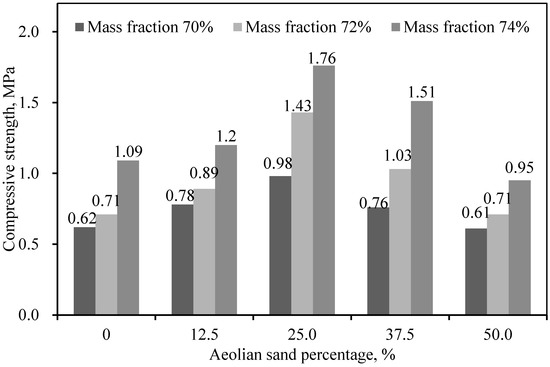
Figure 1.
Compressive strength of specimens cured for 28 days when the cement–sand ratio is 1:8, with varying mass fraction and aeolian sand proportion.
(2) Figure 2 shows the experimental results of slump tests. As we can see in Figure 2, when the mass fraction is 74% (Figure 2a), the flowability of the slurry evidently increases, and self-flowing for the slump is realized and greater than 200 mm. However, the slump is less than 0.18 m when the mass fraction is 76% (Figure 2b), which indicates poor flowability. Thus, the slurry with a mass fraction of about 74% can be regarded as paste-like—that is, homogeneous and simultaneously has a high mass fraction, low dewatering rate, and good flowability [17].
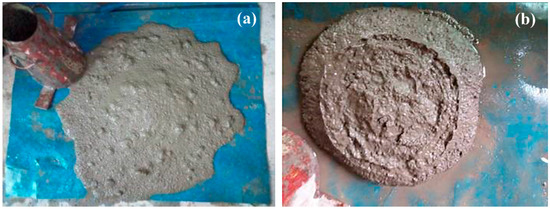
Figure 2.
Slump test: (a) presents specimen (mass fraction of 74%) with slump values of 260 mm, which can realize self-flowing; (b) shows specimen (mass fraction of 76%) with slump values of 180 mm, which is too poor to realize self-flowing [18].
(3) Figure 3 shows the compressive strength of specimens cured for different numbers of days with the changed cement–sand ratio. The compressive strength clearly increased as the number of curing days increased because of the complex physicochemical effects of the hydration reaction. In field applications, the selection of curing period should reflect the strength requirements. The amount of binding material determined the strength of the backfilling body when the other factors were left unchanged. It also can be seen that the compressive strength of the backfilling body increased significantly as an increasing amount of binding material was added.
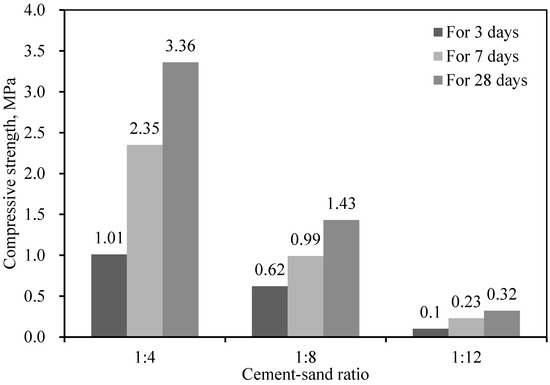
Figure 3.
Compressive strength of specimens cured for different times with varying cement–sand ratio, where aeolian sand proportion is 25% and mass fraction is 72% cured for 28 days, when the cement–sand ratio is 1:8.
(4) Figure 4 presents the compressive stress–strain curve, from which it can be seen that the backfilling body exhibited high elasticity and plasticity, allowing it to efficiently bear the weight of the stopes after breakage [10]. This also suggests that a mixture of aeolian sand and tailings can be provided as backfilling material.
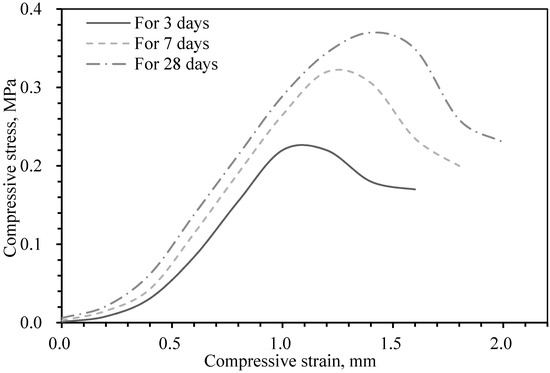
Figure 4.
Typical stress–strain curves of specimens for different curing times where the cement–sand ratio is 1:12 and the aeolian sand proportion is 25%.
(5) Finally, to meet safety requirements and economic considerations, the compressive strength of a backfilling body cured for 7 days and 28 days should not be less than 0.5 MPa and 1.0 MPa. This suggests the use of a slurry with a mass fraction of 72%–74%, a cement–sand ratio of 1:8, and an aeolian sand proportion of 25%.
3.3. Microscopic Analysis of Cemented Backfilling
The specimens were cut into small pieces, and then scanning electron microscopy (SEM) coupled with energy dispersive spectroscopy (EDS) tests [19] were conducted to analyze the microstructure of the specimens and further explore the use of a mixture of aeolian sand and tailings as an aggregate. The experimental process refers to the literature [19]. Figure 5 shows the SEM–EDS analysis of specimens cured for 28 days in the condition that mass fraction is 74%, cement–sand ratio is 1:8, and aeolian sand proportion is 0% and 25%, respectively.

Figure 5.
(a) SEM image of a specimen with aeolian sand proportion of 0%; (b) SEM image of a specimen with aeolian sand proportion of 25%; and (c) The element composition analysis of the area marked in (b) by energy dispersive spectroscopy (EDS).
As shown in Figure 5b, the hydration products of the cement wrapped the backfilling aggregate densely and uniformly, which may be attributed to the complementarity in the particle size distributions of the aeolian sand and tailings at an optimal aeolian sand proportion of 25%, compared with Figure 5a. At this optimal proportion, the grain composition of the aeolian sand improved the aggregate, while the tailings offset the nonuniform coefficient of the aeolian sand.
The EDS analysis showed high oxygen (46.93 At%), silicon (5.33 At%), aluminum (2.33 At%), and calcium (12.81 At%) contents in the cemented matrix micro area, as shown in Figure 5b. This contributed to the formation of CH, CSH, and ettringite, which has a decisive influence on backfilling body strength. Needlelike CH and CSH—the key hydration products in strength gain at advanced age—are ubiquitous in Figure 5a. Besides, ettringite increases the expansibility of concrete to about 120% and improves the flowability of a backfilling slurry [20].
4. Rheological Characteristics
Rheological tests are used to determine the transportation pipeline parameters, and guide the design of the backfilling system [21].
4.1. Viscometer Test
A German Haake VT550 rotational viscometer was used to track apparent viscosity and observe the flow and stress states [22]. Test results were displayed on an LCD screen and printed out by RheoWin software. The VT550 viscometer has three operation modes: control stress (CS), control rate (CR), and control displacement (CD). Using these modes, a variety of curves, such as a fluid curve, viscosity–temperature curve, time curve, and thixotropic curve can be plotted and printed out by RheoWin, and the fluid viscosity, yield, and shear stress can also be measured. The cross-shaped rotor of the VT550 viscometer allows the measurement of slurry specimens with a high mass fraction or which contain large particles. In contrast to a traditional rotational viscometer, this cross-shaped rotor causes minimal damage to the flocculent structure of the specimens and overcomes the slip effect of the cylindrical face.
Contrast tests were conducted on the suggested slurry specimens: S1 (72%, cement–sand ratio = 1:8, aeolian sand proportion = 25%), S2 (73%, cement–sand ratio = 1:8, aeolian sand proportion = 25%), and S3 (74%, cement–sand ratio = 1:8, aeolian sand proportion = 25%). The shear stress and apparent viscosity of specimens S1, S2, and S3 were tracked, and the shear rate–stress curve is shown in Figure 6 after data processing.
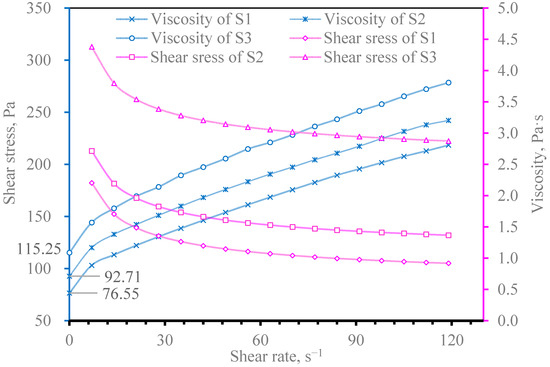
Figure 6.
Shear stress and viscosity curves with stress rate of specimens.
4.2. Analysis of Results
(1) As shown in Figure 5, these slurry specimens all belong to the class of pseudo-plastic fluid with initial yield stress. Slurry specimen S3 (whose mass fraction was 74%) had the largest initial yield stress at 115.25 Pa, while those of S1 and S2 were 76.55 Pa and 92.71 Pa, respectively. However, this value was lower than the boundary value for the initial yield stress of paste and paste-like backfilling slurries (160–220 Pa) [23,24]. The shear stress increased as the shear rate rose. At low shear rates, the apparent viscosity decreased dramatically, and the relationship between shear stress and shear rate became parabolic, while at medium and high shear rates, the apparent viscosity decreased less significantly and the shear rate–stress curve was close to a straight line, which means that they can all be considered as paste-like. In addition, this also means that the initial yield stress was positively associated with the mass fraction; as the mass fraction increased, the particle numbers on the unit cross-section rose, and the driving force required to make the slurry flow also rose.
(2) It can also be seen from Figure 5 that slurry specimens S1, S2, and S3 all showed the time-varying characteristics of shear thinning phenomena, with viscosity decreasing as the shear rate rose. As the shear rate approached infinity, the apparent viscosity reached the limiting viscosity and became stable. It can be seen from Figure 6 that the apparent viscosity of the three slurry specimens all decreased dramatically within the shear rate range of 0–35 s−1, and then leveled off to the corresponding limiting viscosity. At low shear rates, the relationship between shear stress and shear rate was parabolic, while at medium and high shear rates, the shear stress–rate curve was close to linear, due to a slow decrease in viscosity.
5. Evaluation of Application
5.1. Backfilling System
Backfilling systems are divided into backfill material preparation and storage units, backfill material mixing units, and conveying units.
Generally, deep-cone thickener is used for the storage of tailings in recent years [25], and drained aeolian sand can be stockpiled in horizontal sand silos. The cement is transported by tank car and unloaded into the vertical sand silo. The backfilling water resulting from the clarified water was produced by the sedimentation of tailings, which was transported by the pump and delivered to the mixing tanker. Additionally, the high-seated field pond located at the original backfilling station was considered as an alternate resource meeting an emergency need. The above backfilling materials were stirred in the mixing tanker completely so as to form the paste-like slurry with some qualified mass fraction. Afterwards, it was transported to the goaf through the pipeline based on gravity. The backfilling craft process is shown in Figure 7.
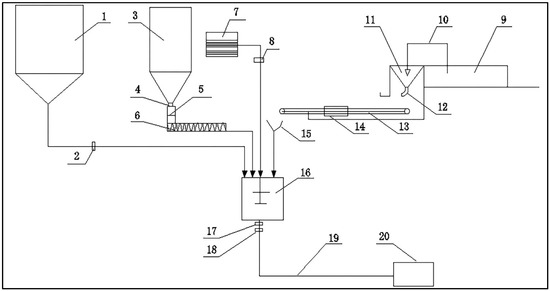
Figure 7.
Backfilling craft process: 1—deep-cone thickener; 2—nuclear densimeter; 3—cement storehouse; 4—star feeder; 5—electronic steelyard; 6—spiral feeder; 7—high-seated field pond; 8—electromagnetic flow meter 1; 9—horizontal sand silo; 10—electronic rake; 11—material-stabilization silo; 12—vibrated feeder; 13—belt conveyer; 14—belt weigher; 15—hopper; 16—mixing tank; 17—densimeter; 18—electromagnetic flow meter 2; 19—pipeline; 20—stope (goaf).
5.2. Evaluation of Application
This cemented backfilling technology of paste-like based on aeolian sand and tailings has been successfully used in “A” mine. The results of the application can be shown as follows:
- (1)
- The production capacity of “A” mine is 3300 t/d, considering the ore density (3.19 t/m3) and the unbalance coefficient of backfilling (1.1–1.2); the backfilling volume of technology was determined to be about 1200 m3/d. Besides, one-shift shut down was given to the plant in consideration of the time of backfilling preparation and maintenance. Although the total investment of the backfilling system is up to $1,994,200, among which the backfilling slurry only costs $6.13 /m3. The cost of this backfilling technology is only 1/5 of the traditional paste-like backfill system because aeolian sand and tailings are all easy and cheap to obtain.
- (2)
- About 30,000 m3 dry tailings can be backfilled to stopes underground per year, which saves approximately $40,000 per year in tailings dam costs. Besides, its contribution to environmental protection cannot be calculated.
- (3)
- Through application evaluation, the backfilling technology has a low accident rate, including pipe blocking, abrasion, and exploding. Additionally, the effect of roof-contacted filling is great, and we can readily tell that the slurry is densely distributed around the stope boundary with the average compress strength of 1.0 MPa (cured for 28 days), which boosts the safety of mining.
- (4)
- During the progress of practices, an activation mixer was added before the backfilling materials into the mixing tank, as it is difficult for the mixing tank to mix the materials completely.
On the evidence as above, this paste-like backfilling technology based on aeolian sand and tailings is fully feasible and reasonable.
6. Conclusions
To study the possibility of utilizing a mixture of aeolian sand and tailings as a backfilling aggregate, physicochemical evaluation, proportioning test, and rheological evaluation were conducted. From which, some conclusions can be drawn:
- (1)
- Aeolian sand and tailings are not ideal backfilling aggregates when considered separately. However, the complementarity of their physicochemical properties allows a mixture of aeolian sand and tailings to be used as backfilling aggregate.
- (2)
- The optimal proportion of aeolian sand content in the aggregate is 25%, at which level the strength of the backfilling body is maximized. We recommend the use of a slurry with mass fraction of 72%–74%, a cement–sand ratio of 1:8, and aeolian sand proportion of 25%.
- (3)
- Viscometer tests were used to analyze the rheological characteristics, and in optimized proportions, the slurry exhibited shear-thinning phenomena with an initial yield stress, and was confirmed to be paste-like.
- (4)
- This cemented backfilling technology of paste-like based on aeolian sand and tailings has been successfully used in “A” mine. It can not only provide a profitable and feasible backfilling craft saving a lot of cost, but is also the first remarkable case in China, offering large enrichment to paste-like backfilling research and is of significant value for similar mines. However, when the early strength of the backfilling body and the mass fraction of slurry are both a little bit low, it may be a good approach to include some hardening accelerator and superplasticizer in the mixture.
Acknowledgments
This study was financially supported by the 12th Five Years Key Programs for Science and Technology Development of China (No. 2012BAC09B02), and the Fundamental Research Funds for the Central Universities of Central South University (No. 2016zzts092).
Author Contributions
Qinli Zhang and Qiusong Chen performed the laboratory experiments and were involved in the manuscript preparation; Qiusong Chen revised the manuscript refer to the reviewers’ comments; Qinli Zhang, Qiusong Chen and Xinmin Wang analyzed the data and approved the manuscript.
Conflicts of Interest
The authors declare no conflict of interest.
References
- Zhang, Q.L.; Cui, J.Q.; Zheng, J.J.; Wang, X.-M.; Wang, X.-L. Wear mechanism and serious wear position of casing pipe in vertical backfill drill-hole. Trans. Nonferrous Metals Soc. China 2011, 11, 2503–2507. [Google Scholar] [CrossRef]
- Wang, X.M.; Zhao, J.W.; Xue, J.H.; Yu, G.-F. Features of pipe transportation of paste-like backfilling in deep mine. J. Cent. South Univ. Technol. 2011, 5, 1413–1417. [Google Scholar] [CrossRef]
- Belem, T.; Benzaazoua, M. Design and application of underground mine paste backfill technology. Geotech. Geol. Eng. 2008, 26, 147–174. [Google Scholar] [CrossRef]
- Benzaazoua, M.; Fall, M.; Belem, T. A contribution to understanding the hardening process of cemented pastefill. Miner. Eng. 2004, 2, 141–152. [Google Scholar] [CrossRef]
- Ouellet, S.; Bussiere, B.; Aubertin, M.; Benzaazoua, M. Microstructural evolution of cemented paste backfill: Mercury intrusion porosimetry test results. Cem. Concr. Res. 2007, 12, 1654–1665. [Google Scholar] [CrossRef]
- Li, S.; Wang, X.M.; Zhang, Q.L. Dynamic experiments on flocculation and sedimentation of argillized ultrafine tailings using fly-ash-based magnetic coagulant. Trans. Nonferrous Met. Soc. China 2016, 26, 1975–1984. [Google Scholar] [CrossRef]
- Yuan, Y.Q.; Wang, X.C.; Zhou, X. Experimental research on compaction characteristics of aeolian sand. Front. Archit. Civ. Eng. China 2008, 4, 359–365. [Google Scholar] [CrossRef]
- Li, T.Y.; Wu, Y.Q.; Du, S.S.; Huang, W.M.; Hao, C.Z.; Guo, C.; Zhang, M.; Fu, T.Y. Geochemical characterization of a holocene aeolian profile in the zhongba area (Southern Tibet, China) and its paleoclimatic implications. Aeolian Res. 2016, 20, 169–175. [Google Scholar] [CrossRef]
- Choudhary, B.S.; Kumar, S. Underground void filling by cemented mill tailings. Int. J. Min. Sci. Technol. 2013, 6, 893–900. [Google Scholar] [CrossRef]
- Kiventer, J.; Golek, L.; Yliniemi, J.; Ferreira, V.; Deja, J.; Illikainen, M. Utilization of sulphidic tailings from gold mine as a raw material in geopolymerization. Int. J. Miner. Process. 2016, 149, 104–110. [Google Scholar] [CrossRef]
- Lim, N. Hydration reaction properties of non-portland cement mortar using paper sludge ash. J. Reg. Assoc. Archit. Inst. Korea 2015, 4, 169–176. [Google Scholar]
- Larson, K.W. Development of the conceptual models for chemical conditions and hydrology used in the 1996 performance assessment for the waste isolation pilot plant. Reliab. Eng. Syst. Safe 2000, 69, 59–86. [Google Scholar] [CrossRef]
- Wang, X.M.; Gu, D.S.; Zhang, Q.L. Theory and Technology of Deep Mine Backfilling; Central South University Press: Changsha, China, 2010. [Google Scholar]
- Fall, M.; Belem, T.; Samb, S.; Benzaazoua, M. Experimental characterization of the stress-strain behaviour of cemented paste backfill in compression. J. Mater. Sci. 2007, 11, 3914–3922. [Google Scholar] [CrossRef]
- Zhang, Q.L.; Jiang, Z.L.; Wang, S.; Chen, Q.S.; Zhu, Y.Y.; Wan, X.H. Pipeline resistance model of the filling slurry transportation with high concentration and superfine total tailing. Sci. Technol. Rev. 2014, 24, 51–55. [Google Scholar]
- Wang, X.M.; Zhao, B.; Zhang, Q.L. Cemented backfill technology based on phosphorous gypsum. J. Cent. South Univ. Technol. 2009, 2, 285–291. [Google Scholar] [CrossRef]
- Chen, Q.S.; Zhang, Q.L.; Wang, X.M.; Xiao, C.C.; Hu, Q. A hydraulic gradient model of paste-like crude tailings backfill slurry transported by a pipeline system. Environ. Earth Sci. 2016, 75. [Google Scholar] [CrossRef]
- Yi, X.W.; Ma, G.W.; Fourie, A. Compressive behaviour of fibre-reinforced cemented paste backfill. Geotext Geomembr. 2015, 3, 207–215. [Google Scholar] [CrossRef]
- Certucha-Barragán, M.T.; Acedo-Félix, E.; Almendariz-Tapia, F.J.; Leal-Cruz, A.L.; Pérez-Moreno, R.; Valenzuela-García, J.L.; Monge-Amaya, O. Iron influence on copper biosorption using anaerobic sludge and its microstructural characterization. Miner. Process. Extr. Metall. Rev. 2011, 32, 60–67. [Google Scholar] [CrossRef]
- Rungchet, A.; Chindaprasirt, P.; Wansom, S.; Pimraksa, K. Hydrothermal synthesis of calcium sulfoaluminate-belite cement from industrial waste materials. J. Clean. Prod. 2016, 115, 273–283. [Google Scholar] [CrossRef]
- Wu, D.; Fall, M.; Cai, S. Coupled modeling of temperature distribution and evolution in cemented tailings backfill structures that contain mineral admixtures. Geotech. Geol. Eng. 2012, 4, 935–961. [Google Scholar] [CrossRef]
- Markin, V.I.; Cheprasova, M.Y.; Bazarnova, N.G.; Frolova, E.O. Pine wood carboxymethylation under microwave radiation. Russ. J. Bioorg. Chem. 2014, 7, 733–736. [Google Scholar] [CrossRef]
- Wang, X.M.; Li, J.X.; Xiao, Z.Z.; Xiao, W.G. Rheological properties of tailing paste slurry. J. Cent. South Univ. Technol. 2004, 1, 75–79. [Google Scholar] [CrossRef]
- Wu, A.X.; Wang, Y.; Wang, H.J.; Yin, S.H.; Miao, X.X. Coupled effects of cement type and water quality on the properties of cemented paste backfill. Int. J. Miner. Process. 2015, 143, 65–71. [Google Scholar] [CrossRef]
- Jiao, H.; Wu, A.X.; Wang, H.J.; Yang, S.K.; Xiao, Y.-T. The Influence of Cemented Paste Backfill on Groundwater Quality. Procedia Earth Planet. Sci. 2011, 2, 183–188. [Google Scholar] [CrossRef]
© 2016 by the authors; licensee MDPI, Basel, Switzerland. This article is an open access article distributed under the terms and conditions of the Creative Commons Attribution (CC-BY) license (http://creativecommons.org/licenses/by/4.0/).